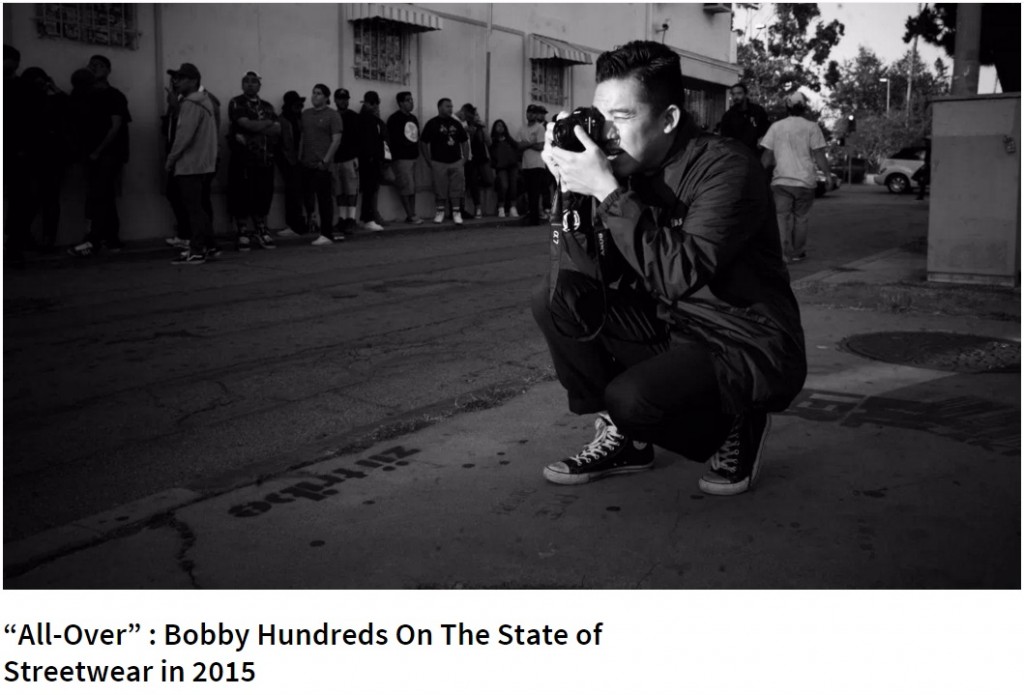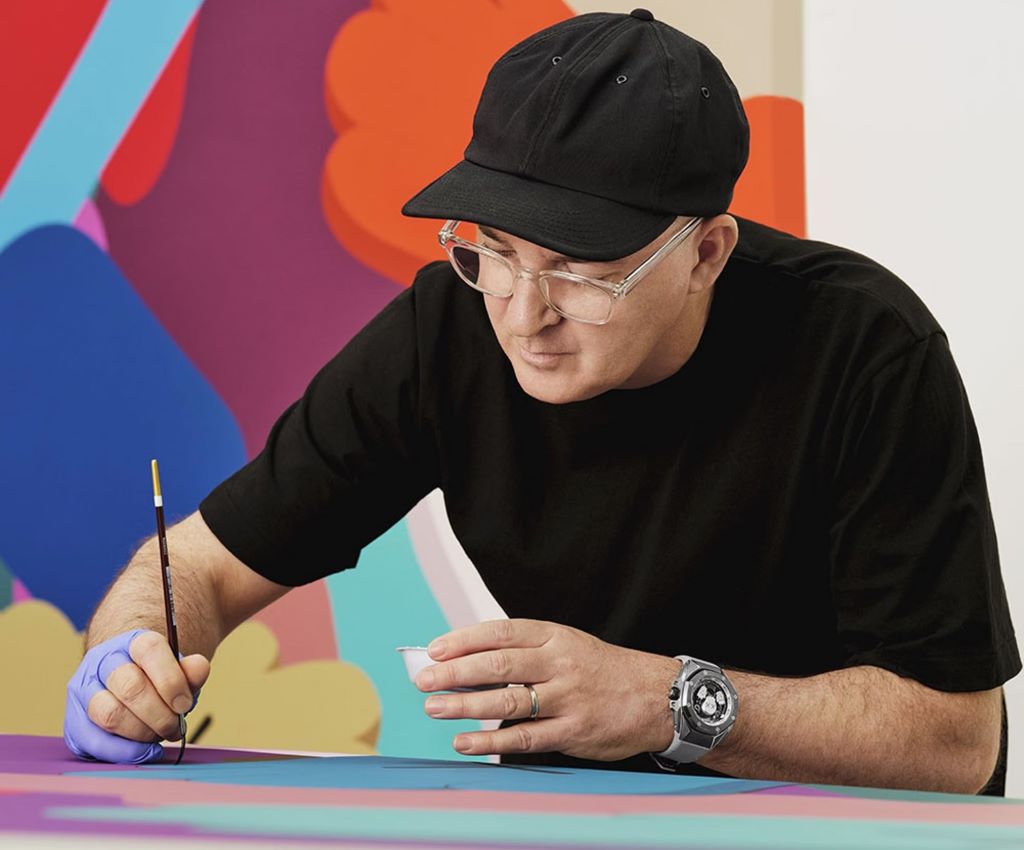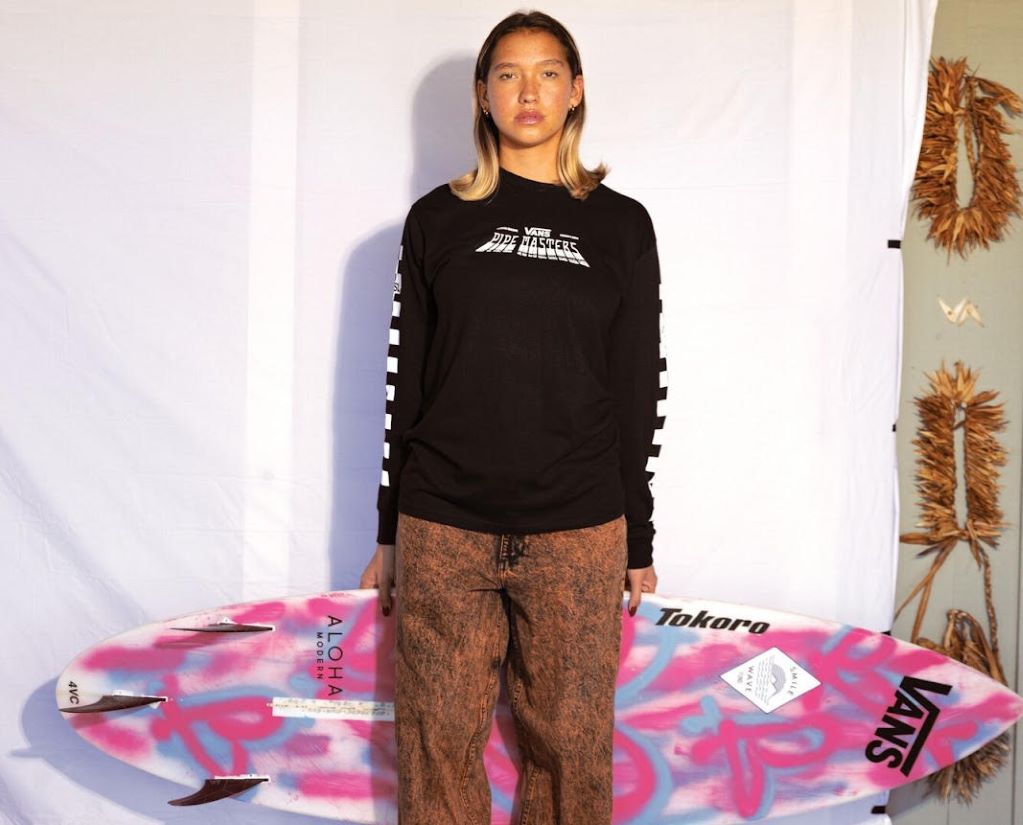Founder of California streetwear label The Hundreds, Bobby Kim, better known on the scene as Bobby Hundreds, has penned an essay for Hypebeast examining why his label and other in the streetwear space are looking back at 2015 as their worst year ever. Kim has always had a way with the written word and his friendly forthright style combined with an earnest reputation is reflected in the comments (now at 335-plus ) where the usual ornery beast-mode feedback has been replaced with a lot of thoughtful exchanges including Kim himself chopping it up with readers.
Kim identifies wider distribution (and in the comments readers repeatedly called out The Hundreds’ opening Zumiez and PacSun as a major mistake), changing fashion trends and disruption caused by widespread availability of online selling platforms as three major reasons for streetwear’s difficulties.
Having covered city-based trends for over two decades from reviewing Triple Five Soul in its first Ludlow Street location to attending urban fashion shows featuring PNB Nation and FUBU held at west side Manhattan convention spaces to writing trend pieces on the takeover of Tommy Hilfiger at a mid-90s Puerto Rican Day parade, it’s clear that longevity aka staying power is not only not the norm, it’s extremely uncommon, not just among clothing brands but all businesses.
So while it’s true that brands at the minimum need to have a strong creative vision, be mindful of who their customer is and isn’t, and also be able to stay fresh and pivot as trends change, sticking around for longer than ten years–the typical time a well run brand with good creatives can ride a strong fashion wave–requires something more.
Longevity Is The Rarest Trait
Commenters in the HypeBeast story repeatedly called out Supreme and Stüssy as brands that have staying power, crediting their longevity in large part on their tight distribution, which, let’s be real, Stüssy just like The Hundreds sells to a bunch of mall chains and even one of its owners thinks it’s gotten too big so maybe 2015 wasn’t so hot for it either. Still, given Stüssy was founded in 1984 with its first store opening in SoHo in 1991 and Supreme was founded in 1994, one can’t deny their success and staying power, which Stüssy executive David Sinatra (son of co-owner Frank Sinatra Jr.) credits in part to having a global business that enabled it to get through difficult times. I think we all know that without Japan, Supreme’s current state of affairs might be entirely different, too.
Surprisingly, no mention was made of industry titans Adidas and Nike (founded in 1949 and 1964 respectively), both of which have seen their popularity come and go, but have managed to ride through some very tough storms. Similar to Stüssy and Supreme, Adidas and Nike have global businesses that have helped them smooth out bumps in the road, but the bigger truth is they’re deeply embedded in streetwear and a big part of their modern-day formula for success has come at the expense of brands like The Hundreds and others.
Adidas And Nike’s Uzis Weigh Several Billion Tons
For most of its history, Adidas’s and Nike’s growth was built on attaching itself to the culture of competitive sports. Not forgetting the massive amounts of money they spend to attach their logos to some of the world’s most widely viewed sport teams, both heighten their connection with sport competition by repeatedly projecting the message they are dedicated to technological innovation, constantly introducing new “performance-enhancing” silhouettes, constructions and fabrics that have enabled them to stay one up on labels offering plain ole shirts or bottoms, which–womp/womp–only cover your body, a lot less cool than ones that help you jump higher, run faster and be an all around more winning human being.
In addition to sport team related marketing, Adidas and Nike both have massive marketing budgets, or as Nike terms it “demand creation” that enable them to build brand equity unimpeachable enough that their apparel and shoes appeal to everyone from the snobbiest collector to the value-oriented parent looking for a bargain at her/his local J.C. Penney. So much for the belief that it’s impossible for a widely distributed brand to stay cool, right?
Nike in 2015 spent $3.2 billion just to make you want to buy their stuff, and Adidas’s total spend for sales and marketing for the first nine months of 2015 was $1.9 billion. Kind of astounding when you compare those numbers to major success story Stüssy’s annual sales that seem positively unassuming at $50 million a year. Even at its height in 2012, streetwear supermarket Karmaloop seems teeny-tiny in comparison with its mere paltry take of $127 million in sales annually.
Now here comes the tricky part, the one that separates Adidas and Nike from pesky up-and-comer Under Armour. This is also the part that brings everything back to some of the issues currently plaguing streetwear brands. While Adidas and Nike have always had credibility in the hood vis-a-vis the very many talented black football and basketball athletes they sponsored–including and especially the game-changing Michael Jordan for Nike–until the rise of rise of a global sneaker boutique network in the late ’90s/early 00s, their relationship with street culture was more often than not one kept at arm’s length one.
Everything I Know Learned From Sneaker Boutiques
Early on Nike picked up on the importance of sneaker boutiques and their ability to influence what was to become the blueprint for collector culture. Very quickly, it embraced the concept of collaborations with influential individuals and entities other than athletes, and at the same didn’t hesitate to muscle out upstart brands attempting to enter the space, in particular those attempting to make their entry via Nike tribute silhouettes. Case in point the cease & desisted Ari Menthol 10, a knock off of the Air Force 1, along with JB Classics, whose founder was turned away by multiple”tastemaker” boutiques that said they couldn’t carry shoes like his because of agreements with Nike not to sell look-a-like product.
Fast forward to 2015 and though the sneaker boutique culture is still alive and has even been co-opted by high-end department stores, most owners will tell you one of the biggest changes over the past few years has been managing the huge uptick in sneaker launches from all brands though especially Nike. No retailer can survive without Nike, but at the same time, far from all their shoes evaporate upon arrival and in the meantime they tie up a ton of open to buy dollars, which might otherwise go to giving an indie streetwear label or two a bit more space in their stores.
Money changes everything…..up to a point, tides advance and recede even for Swooshy and in the year 2015, Nike finds itself in the odd spot of the shoe being on the other foot with Adidas Originals Yeezy Boost suddenly sucking all of the cool out of the room, a rise in popularity that has been so intense that Nike in December moved a retro Jordan launch date to avoid going head-to-head with the Yeezy. At the same time, while Under Armour has seen tremendous growth and has a certifiable hit partnership with Steph Curry, the truth is the brand holds zero sway with the streets or influencer culture. Its own biggest star is a product of a well off suburban family, and as such, when it comes to street culture, UA remains the ultimate outsider.
I Can Do That!
Streetwear brands and sneaker boutiques haven’t just helped bring cool to Nike and Adidas, they’re methods have also been picked up on by well-financed luxury labels with leadership at the savvier ones (like Givenchy’s Riccardo Tisci) mimicking the concept of signature graphics and also collaborations.
Increased competition has also come with the development of hybrid street/luxury brands like Off White, Hood By Air, Public School NY and Yeezy (!) whose members are of street culture, but whose seasonal presentation methods are more in step with that of traditional fashion brands, making them more appealing for coverage by old school fashion magazines like GQ and Vogue, which, on the low, you would think had a personal vendetta against streetwear brands given its practically non-existent coverage of the space (though at the same time still showing lots of love to Adidas and coughdemandcreationcough Nike!). Being frozen out of coverage by fashion media titans is sort of good in that it enforces the brands’ outsider status but sort of bad in that it limits their ability to not only speak to a more moneyed audience but also be seen as legit by outside investors.
A lack of global presence, competition from better financed brands, plus scant funds for marketing efforts all point to a rather grim future for streetwear, it’s true, and yet personally I’m rooting for The Hundreds and other brands (shouts esp to MTTM & HLZ) to persevere even though it won’t be easy.
Streetwear in many has always been the savvy bastard stepchild of alt cultures punk rock and hip hop, learning from the mistakes of both–one of which stupidly refused to dance with the devil at all and the other who dumbly tried to befriend him. The end results were quasi the same, punk ended up in a museum retrospective curated by Anna Wintour and urban got screwed over by Macy’s.
One thing is certain, the streetwear movement and its lead players should be proud of their many accomplishments, most of all their creativity. The ideas they spawned have been genuinely game changing for fashion, retail and media and they definitely do NOT receive anywhere near the credit they deserve. And ultimately it will be that creativity that keeps them at the dance, not money. On this New Year’s Eve of 2016, a toast to the coming year being one where streetwear begins to uncover the answers that will make its game plan a long one.






